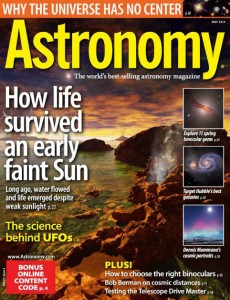In its May 2013 edition, Astronomy Magazine printed an article by Philip Plait entitled ”The science behind UFOs” and a column by Glenn Chaple ”Close Encounters”.
As both articles are essentially a simple refutation of the ”extraterrestrial hypothesis” and do nothing to further serious investigation of the UAP phenomena, I have sent the below comments to Astronomy magazine:
[Note: for the interested readers, a general list of a few sightings by astronomers can be found at the following links:
– http://files.ncas.org/ufosymposium/mcdonald.html#astronomers
– http://www.nicap.org/ufoe/UFO%20Evidence%201964.pdf
(section VI, page 102)]
——————————————–
About Close encounters and the science behind UFOs
In its May 2013 edition, Astronomy Magazine printed an article by Philip Plait entitled ”The science behind UFOs” and a column by Glenn Chaple ”Close Encounters”. I believe that both writers confuse the issue of extra-terrestrial intelligence with the issue of UFO, as they seem to associate this acronym with alien spacecraft.
Although that it is well known that many UFOs sightings are mistaken identifications of common phenomena by people with little experience at looking at the sky, this is not a valid argument for dismissing all sightings and discrediting the whole topic. I agree with the authors that turning UFOs into IFOs is important, as cataloguing known events to dispel errors and correct misinterpretations can help the public to understand many diverse natural and man-made phenomena that take place in the sky. On the other hand, it appears that this approach is incomplete and risks narrowing our ”functional fixedness”.
It is important to leave open the possibility that there are yet new discoveries to be made. Whenever there are unexplained atmospheric observations, there is the possibility for scientists to learn something new by studying those sightings. Unexplained aerial phenomena should be treated seriously and a rigorous scientific evaluation of credible sightings should be done, as from a scientific point of view they may represent an unknown and unexplained phenomenon.
Open and rational discussion of the topic should be encouraged. Ignoring or refusing to discuss or debate challenging and unidentified UFO cases could lead some to conclude that science has something to hide, therefore fuelling all sorts of conspiracy theories. In addition, it can be argued that paying more attention to UFOs or at least being more respectful would be a welcome signal to the public that science does not dismiss topics the public find intriguing. It would also show that science does not dismiss an experience that occurs to a non-negligible portion of the public (5-10% of the public report a UFO sighting). Moreover, almost every new discovery in astrobiology and astronomy increases the probability of extra-terrestrial life, and answering questions such as what extraterrestrials could be like and will they ever visit us makes astronomy interesting to young people. Ignoring the possibility or refusing to discuss it doesn’t.
Finally, I agree with the authors that astronomers (like pilots) are, on average, better observers. However it is important to add that some of them, including well known and respected astronomers, such as Clyde Tombaugh or Lincoln La Paz, have indeed observed UFOs.
——————————
